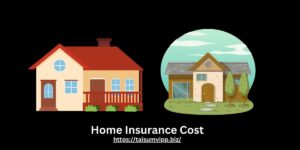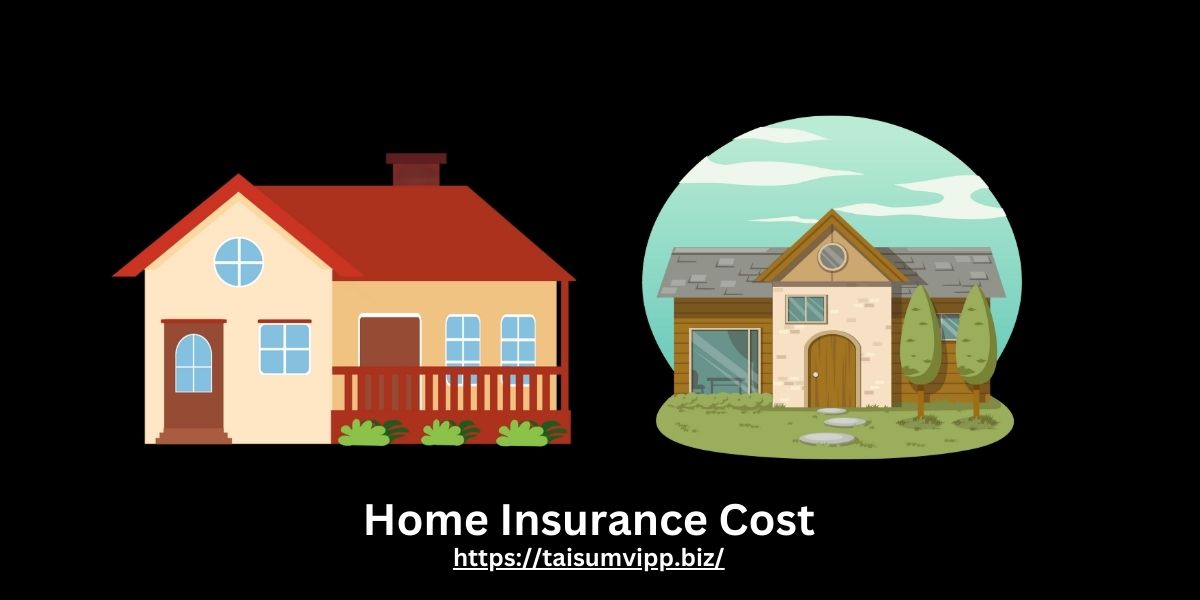A Comprehensive Guide
Home insurance is crucial to homeownership, providing financial protection against unexpected disasters. Understanding the elements that contribute to home insurance costs can help homeowners make informed decisions regarding their policies. In this comprehensive guide, we will explore the basics of home insurance, the factors that influence its cost, the various types of policies available, how to calculate the costs, and tips on reducing expenses.
The Basics of Home Insurance
What is Home Insurance?
Home insurance, often referred to as homeowner’s insurance, is a type of property insurance that protects a home and its contents from damage or loss. This coverage typically includes protection against events such as fire, theft, vandalism, and certain natural disasters. Homeowners pay a premium to maintain this insurance, which can provide peace of mind.

In addition to protecting the physical structure of the home, homeowner’s insurance also covers personal belongings inside the home and may provide liability coverage in case of accidents occurring on the property. This multifaceted protection makes home insurance an essential component of responsible home ownership. Furthermore, many policies offer additional living expenses coverage, which can help pay for temporary housing if your home becomes uninhabitable due to a covered event. This aspect of home insurance ensures that you and your family can maintain a semblance of normalcy during challenging times, alleviating some of the stress that comes with home damage.
Why is Home Insurance Important?
The importance of home insurance cannot be overstated. It not only safeguards your investment from unforeseen events but also provides financial stability during difficult times. If a disaster strikes, having adequate home insurance can help cover repairs and replacements, thereby preventing significant financial loss.
Moreover, mortgage lenders often require homeowners to have insurance as a condition of the loan. This underscores the role of insurance in protecting both the homeowner and the lender’s interests, ensuring that the investment remains secured in the event of damage or loss. Additionally, home insurance can also offer coverage for personal liability, protecting homeowners from legal claims resulting from injuries that occur on their property. This means that if someone were to slip and fall in your home, your policy could help cover legal fees and settlements, providing an extra layer of security for your financial future. Understanding these various aspects of home insurance can empower homeowners to make informed decisions about their coverage and ensure they are adequately protected against life’s uncertainties.
Factors Influencing Home Insurance Cost
Location and Its Impact on Cost
Your home’s location is one of the most significant factors influencing insurance premiums. Areas prone to natural disasters, such as floods or earthquakes, typically face higher premiums due to increased risk. For instance, properties situated in coastal regions may require additional coverage against hurricanes.
Additionally, crime rates in a particular neighborhood can also affect insurance costs. High-crime areas may lead to increased premiums as insurers consider the likelihood of theft or vandalism. Understanding local risk factors can help homeowners assess their insurance needs. Moreover, proximity to fire stations and emergency services can also influence costs; homes located near these facilities may benefit from lower premiums due to quicker response times in emergencies, thus reducing potential damage and loss.
The Role of Home Size and Construction
The size and construction materials of your home also play a pivotal role in determining insurance costs. Larger homes generally incur higher premiums because they require more extensive coverage. Similarly, homes built with expensive materials or custom features—like a stone façade or elaborate roof—may cost more to insure than standard constructions.
Additionally, the age of the home matters. Older homes may be perceived as riskier investments due to outdated electrical systems or plumbing, leading to higher insurance costs. Homeowners should be aware of these factors when evaluating their insurance premiums. It’s also worth noting that certain architectural styles may carry different risks; for example, homes with flat roofs may be more susceptible to water damage, prompting insurers to adjust premiums accordingly. Regular maintenance and updates can mitigate some of these risks and potentially lead to more favorable insurance rates.
The Effect of Home Security Measures
Implementing home security measures can effectively reduce insurance costs. Insurers often provide discounts for homeowners who install alarm systems, deadbolts, or surveillance cameras, as these features decrease the risk of theft or damage.
Furthermore, having a smoke detector and a sprinkler system can also contribute to lower insurance premiums. Homeowners should inquire with their insurance providers about available discounts for security measures to leverage potential savings. In addition to these measures, being part of a neighborhood watch program or utilizing smart home technology, such as smart locks and motion-sensor lights, can further enhance security. These proactive steps not only protect your home but also signal to insurers that you are taking responsible actions to mitigate risks, which can lead to even greater discounts on your policy.
Types of Home Insurance Policies
Comprehensive Home Insurance
Comprehensive home insurance is often the most inclusive policy available. This type of policy typically covers a wide range of risks, including natural disasters, theft, and liability claims, ensuring extensive protection. Homeowners who choose this route can feel secure knowing they have a safety net for various potential hazards.
Basic Home Insurance
Basic home insurance, as the name suggests, offers fundamental coverage. It usually covers only the most common risks, such as fire and theft, making it a more affordable option. While it might lack the extensive coverage of a comprehensive policy, basic insurance can still provide essential protection for homeowners on a budget.
Specialized Home Insurance Policies
For homeowners with unique properties or specific needs, specialized home insurance policies may be ideal. These policies cater to certain risks, such as coverage for historic homes, high-value contents, or rental properties. Homeowners should assess their individual situations to find the most suitable coverage option.
How to Calculate Home Insurance Cost
Understanding Insurance Premiums
Insurance premiums are the regular payments made to maintain coverage. Several factors contribute to the determination of these premiums, including the aforementioned ones—location, size, construction type, and security features. Insurance companies also consider the homeowner’s credit history and previous claims when calculating rates.
It’s also important to note that premiums can vary significantly between insurers, so shopping around is vital. Comparing quotes from multiple providers can enable homeowners to find a plan that suits both their coverage needs and budget.
Deductibles and Their Role in Cost
Deductibles are another important consideration in calculating home insurance costs. A deductible is the amount that a homeowner must pay out-of-pocket before the insurance kicks in. Generally, higher deductibles lead to lower premiums, making it essential for homeowners to choose a deductible amount that reflects their financial situation.
When selecting a deductible, homeowners should consider their ability to cover that amount in the event of a claim. Balancing premiums and deductibles is vital to ensuring adequate financial protection without straining the budget.
Ways to Reduce Home Insurance Cost
Tips for Lowering Your Premium
There are several strategies homeowners can employ to reduce their home insurance costs. First, maintaining a good credit score can help obtain lower rates. Insurers often reward responsible financial behavior with better premiums.
Additionally, regularly reviewing your home insurance policy for any outdated coverages or limits can lead to cost savings. Homeowners may find that they no longer need certain coverages or that they could benefit from new discounts based on recent improvements to their property.

The Benefits of Bundling Insurance Policies
Bundling home insurance with other types of insurance, such as auto or life insurance, can lead to significant savings. Most insurers offer discounts for customers who choose to combine their policies, which can lower overall insurance costs.
When considering bundling, homeowners should ensure that the bundled policy still meets their specific needs and that they are receiving the best coverage available. By evaluating options, families can protect their homes economically while securing adequate coverage.
In conclusion, understanding the various aspects of home insurance costs is essential for homeowners. By taking into account the relevant factors, exploring the types of policies available, and implementing strategies to save on premiums, individuals can secure a comprehensive insurance plan that provides peace of mind and protection for their most valuable asset.
